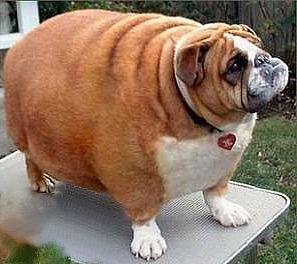Do you have a chubby Collie? Is your Puli looking a little roly-poly? You???re not alone: canine obesity is a common problem. Here are the tell-tale signs of an overweight dog and some tips for getting your pet in shape
 You???ve probably heard about the obesity problem, but you may not be aware that it is not only a problem in humans but also among our canine population.
You???ve probably heard about the obesity problem, but you may not be aware that it is not only a problem in humans but also among our canine population.
In fact, canine obesity is the most common nutritional disorder seen in dogs. It???s caused by more energy being taken in than is used, giving rise to a persistent and potentially life-threatening energy surplus.
This excess energy is stored mainly as fat, but there are many other factors also contribute to canine obesity: age, sex, reproductive status (whether or not it is neutered), inactivity, genetics, food intake, diet, environment, lifestyle, and any underlying diseases that impair exercise and result in excessive weight gain.
The signs of obesity are numerous. For example, you may struggle to see or feel your dog???s ribs, spine or waist line. Your pet could show abdominal sagging or have a bigger, rounder face; it may be reluctant to go for walks, lag behind, pant excessively or appear tired and lazy.
Probably the most important factors influencing obesity in our pets are the heavily branded commercial foods, highly palatable diets and table scraps we feed to them. And like humans, ageing dogs become less active and need less daily energy, so it???s no surprise that if their food intake is not decreased proportionately, they can easily pile on the pounds.
So to help prevent your dog becoming obese, avoid feeding it scraps or leftovers, and check the feeding guides on packaging, weighing out the recommended amount in the morning. Ensure that every family member has clear instructions for pet feeding too. Divide your dog???s daily amount into several meals, and if introducing a new food, remember to do it gradually, mixing new with old.
It is vital that dogs maintain a healthy weight, as obesity can commonly result in diabetes (the pancreas fails to secrete enough insulin to regulate blood glucose levels), heart disease (due to high cholesterol levels), and arthritis (which directly affects mobility, making it even harder to lose weight).
If your dog is overweight, there are several things you can do to help it get back in shape. Gradually change its feeding habits, increase the level of exercise it does, look at the type and intake of food it eats, and develop a feeding plan, including regular vet visits for free weight checks to record your progress.
High-protein, high-fibre but low-fat diets are typically recommended for weight loss, as they give dogs the feeling of being full and provide more energy. You???ll soon start to notice that when your pet loses weight, it will be happier and more inclined to exercise. So why not start right away by replacing fatty treats with carrot sticks?
For more advice about canine obesity and helping your dog lose weight, make an appointment to see your vet.


